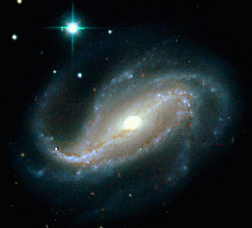The Orion Nebula
Click on image for full size
NASA
Nebulae - The Dust of Stars
Nebulae are stardust. The gas in nebulae is used to make new
stars. Dying stars create nebulae from their gas. While stars are made
of very hot, dense gas, the gas in nebulae is cool and spread out.
Water is at least 1,000,000,000,000,000 times as dense as the gas
found in nebulae. Nebulae come in many shapes. They can be round or
ring-shaped, and some look like the wispy clouds that float through
the sky on a nice summer day.
There is lot of gas that we can't see in the
Galaxy. Something must happen for the
nebulae to reveal themselves. What happens to make nebulae glow? Some
are
stellar nurseries where new stars are born.
The young stars are extremely hot and provide a lot of energy for
lighting up nebulae. Some nebulae are created by dying stars:
supernova remnants and the planetary nebulae
surrounding
white dwarfs.
You might also be interested in:

The Sun and planets began as a cloud of gas, just like the one shown in this picture. Such a cloud is called a Nebula. It is made of molecules. "Nebulae" is a word that means more than one nebula. The
...more
Scientists used the Hubble Space Telescope to look at an old nebula. It's called the Ring Nebula. They used to think that it was shaped like a ring but it isn't. Pictures from the HST show that it's really
...more
This is a picture that the Hubble Space Telescope took of a nebula. Nebulas are clouds of gas in outer space from which stars form. Because it is red and white and green, it looks like something that could
...more
Astronauts put a new camera on the Hubble Space Telescope in March 2002. The camera is working great! It took the four pictures to the left. Scientists sometimes give things out in space funny names, especially
...more
Scientists have found that spiralgalaxies collide more than we thought! Have you seen a galaxy? (In case you haven't, there is a picture on the left!) A new camera can see through dust and find bands of
...more
PAH is the short name for "Polycyclic aromatic hydrocarbons". Thank goodness this molecule has a short name! These are long strings of carbon atoms which form a ring. (That accounts for the "cyclic" and
...more
Cassiopeia was the queen of an ancient land. She and her husband, Cepheus, had a daughter named Andromeda. Cassiopeia would always say she was prettier than the sea nymphs. A monster called Cetus was
...more
Let's pretend that you're on the top of a mountain in Arizona and you have a cannon. Let's make it a game; the object of the game is to to fire a cannonball and hit a flag pole that's on the top of another
...more














